Complete Guide to Buddhist Mantra Yana Practice: 4 Foundations and 9 Tips for Maximizing Mantra Benefits
How do we correctly chant mantras for maximum benefit? Are the rules for guiding mantrayana practice? What are the prerequisites of mantra practice? In this presentation, we cover the prerequisites, the indispensibles, and offer 9 tips and practices for...

 A devoted Buddhist of faith chanting mantras. The important points of practice are the foundations of Faith and Compassion.
A devoted Buddhist of faith chanting mantras. The important points of practice are the foundations of Faith and Compassion.How do we correctly chant mantras for maximum benefit? Are the rules for guiding mantrayana practice? What are the prerequisites of mantra practice? In this presentation, we cover the prerequisites, the indispensibles, and offer 9 tips and practices for maximizing the benefit of your mantra practice.
Guru Rinpoche, the great Lotus Born Padmasambhava, advised his great disciple Lady Yeshe Tsogyal on how to practice mantrayana:
“You must possess the key point of faith free from fluctuation, like a river.
You must possess the key point of compassion free from enmity, like the sun.
You must possess the key point of generosity free from prejudice, like a spring of drinking water.
You must possess the key point of samaya free from flaws, like a crystal ball.”
This is the foundation for practicing mantra yana. All four of these are far more important than mechanics like “proper pronunciation.”
 A devoted and faithful man chants mantras daily at Bouddanath Temple in Katmandu, Nepal.
A devoted and faithful man chants mantras daily at Bouddanath Temple in Katmandu, Nepal.
Faith and Compassion are Indispensable
What did Guru Rinpoche mean when he talked about the key points of faith and compassion? For mantra, or any other Buddhist practice to have a profound impact in our lives, we have to start from the right place — before we even worry about how to pronounce the mantra.
For example, every location on a map needs two coordinates. For mantra, the two coordinates are faith and compassion. In Buddhism, faith arises from Wisdom, not blind adherence to doctrine. For this reason, in Mantrayana, the two wings of the bird of Enlightenment are Wisdom and Compassion.
Put another way, to practice Mantrayana, in a worthwhile way, we have to be motivated by Bodhichitta, the intention to benefit all sentient beings. Without that motivation, it is not a Mahayana Buddhist practice. Once we have the motivation, we have to have the Wisdom of Faith.
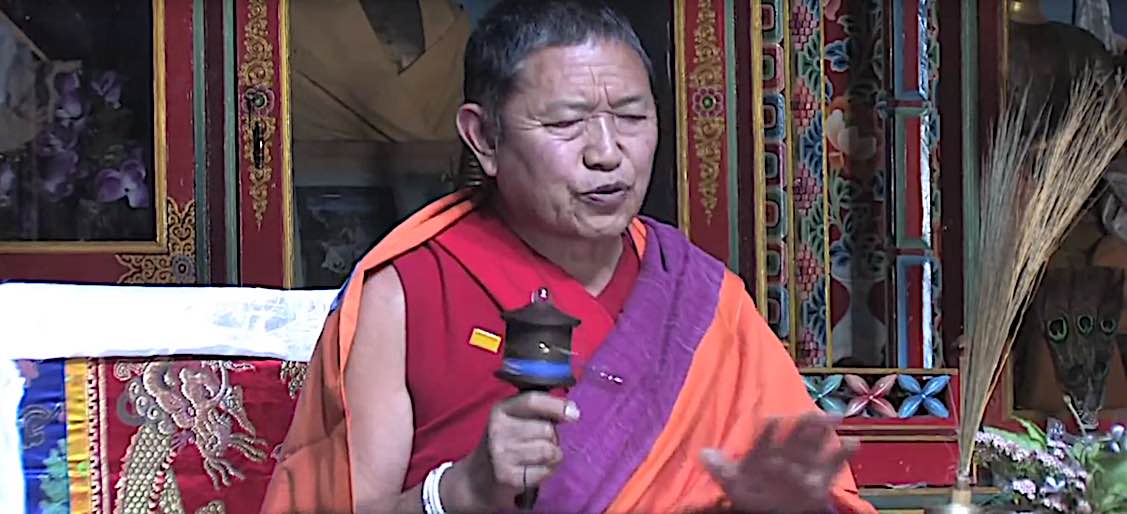 Garchen Rinpoche with his ever-present mani (mantra) prayer wheel, chanting mantras. The “Mantra Wheel” is another way of practicing mantras, with each spin of the wheel sending out the blessings of the millions of mantras inside the wheel (on microfilm.) His Eminence Garchen Rinpoche said, ““For those who turn the prayer wheel… during the times of the great festivals, but also daily, it is like the continuous flow of an unobstructed river. For those sentient beings in the three lower realms the turning churns them up from the depths… if the yogic practitioner turns, the two aims will be instantaneously accomplished.” For a feature on Prayer Wheels, see>>
Garchen Rinpoche with his ever-present mani (mantra) prayer wheel, chanting mantras. The “Mantra Wheel” is another way of practicing mantras, with each spin of the wheel sending out the blessings of the millions of mantras inside the wheel (on microfilm.) His Eminence Garchen Rinpoche said, ““For those who turn the prayer wheel… during the times of the great festivals, but also daily, it is like the continuous flow of an unobstructed river. For those sentient beings in the three lower realms the turning churns them up from the depths… if the yogic practitioner turns, the two aims will be instantaneously accomplished.” For a feature on Prayer Wheels, see>>
We have faith in the correctness of the teachings, the Dharma, the Budhda, and our lineages of teachers. With that faith, motivated by our compassion and Bodhichitta, we have all the qualifications we need to practice mantrayana.
His Eminence Garchen Rinpoche, in guidelines for mantra practice wrote said, “the main requirement for mantra chanting of any Enlightened Deity according to the teachings, is Bodhichitta intention.”
Compassion and Wisdom as Foundations
In Guru Rinpoche’s four foundations for practicing mantra effectively, he also highlighted generosity, and remaining true to the Bodhisattva vow to help all sentient beings, or keeping our Samaya.
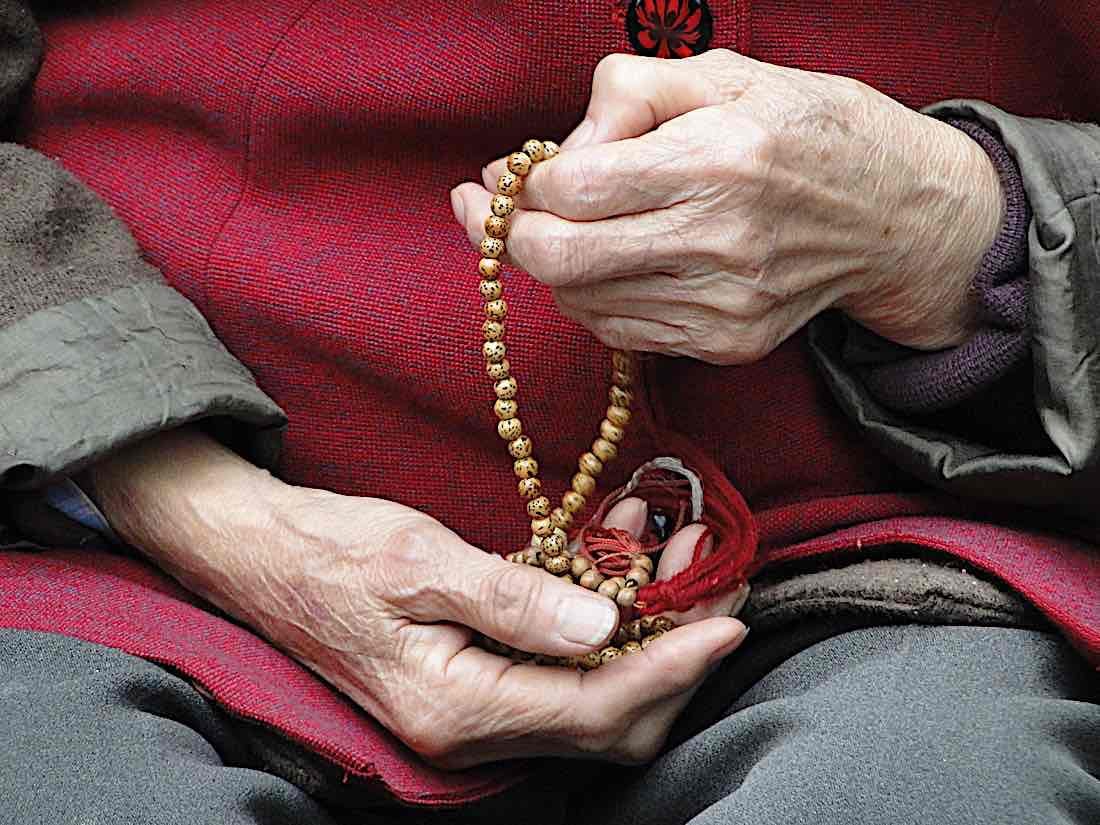 Repeated mantra recitation is a form of concentration and mindfulness.
Repeated mantra recitation is a form of concentration and mindfulness.
The Lady Who Had Faith
In a lovely story on Dharma Drum Mountain’s website, they describe the famous story of the lady who had faith, a beautiful teaching story on the power of faith:
 A lovely Buddhist contemplating with her mala beads.
A lovely Buddhist contemplating with her mala beads.
“In ancient times, there lived an old lady who diligently recited the “Brilliant Mantra of Six Words Om mani padme hum” for many years.
One day, a realized Buddhist master happened to pass by; from a distance, he saw the house enveloped in a luminous glow, and thought that there must be a practitioner with great achievements inside. Upon entering, he saw an illiterate elderly lady reciting the mantra who was even mispronouncing the last word. With good intention, the master corrected her mistake—only to find that, as he left the house and looked back, the glow from within the house had vanished.
The old lady was filled with remorse after the master corrected her pronunciation, thinking that her mistake in pronunciation had negated all those years of practice. This, in turn, caused her to lose focus in her recitation and any spiritual response from it.
“When the master realized what had happened, he went back and told the old lady that he misremembered, and she should continue her recitations as before; that is, her pronunciation was not wrong. Before the master left, he looked back to see that the house was glowing once again.”
 Guru Rinpoche recommended “never be separated from your mala.” This symbolically means “never be separated from the Dharma”
Guru Rinpoche recommended “never be separated from your mala.” This symbolically means “never be separated from the Dharma”
This shows that the core of mantra recitation lies in the sincerity of our heart and the focus of our mind and our faith.
Generosity as a Foundation
Why generosity? Mantrayana is a practice within the great vehicle of Mahayana — where we generously accept our role as a Bodhisattva, with the promise to help others. This makes Bodhichitta and generosity the most important mantra qualification. This is manifested in our practice as our Samaya.
 His Eminence Garchen Rinpoche explaining Refuge and the Bodhisattva Vow.
His Eminence Garchen Rinpoche explaining Refuge and the Bodhisattva Vow.
Samaya as Foundation
Why did Guru Rinpoche single out Samaya as one of the four methods? Samaya means promise or vows — in the case of Buddhists, this is primarily our Boshisattva Vows. In the case of some Vajrayana practices, that might also include our Tantric Vows.
Guru Rinpoche is emphasizing that our Bodhisattva Vows are a requirement of any practice in Mantrayana and Vajrayana. For example, chanting a mantra with the intention to destroy or harm another sentient being is simply not even possible with Buddhist Mantras. Bodhisattvas help all sentient beings and Mahayana Buddhists take the Bodhisattva vow to empower our Bodhichitta goal.
For mantra to be effective we must keep the Bodhisattva Vows. This is sometimes called the Ten Vows of Samantabadhra, which are found in the Samantabhadra-caryā-praṇidhānam:
I vow to pay homage to all the Buddhas and Bodhisattvas.
I vow to praise the virtues of the Buddhas and Bodhisattvas.
I vow to serve and make offerings to the Buddhas and Bodhisattvas.
I vow to confess past misdeeds and uphold the precepts.
I vow to rejoice in the merit and virtues of Buddhas, Bodhisattvas and all sentient beings.
I vow to ask the Buddhas and Bodhisattvas to teach the Dharma.
I vow to ask the Buddhas and Bodhisattvas to refrain from entering nirvana.
I vow to always follow the Buddhas’ teachings.I vow to benefit all sentient beings.
I vow to dedicate the merit from all practices to the liberation of all beings.
 Bell and Mala are practice supports.
Bell and Mala are practice supports.
Tips to Empower Your Mantras
With these four foundations of Guru Rinpoche in mind, what can we expect in terms of benefits. We covered, these in depth in another presentation (embedded below), the 9 Benefits of Mantra as taught by Guru Rinpoche:
We also covered extensively the method of using your mantra support, which is your mala:
In the rest of this presentation, we’ll focus simply on how to optimize mantra practice.
An important starting tip is: don’t let anyone tell you, that you are doing it all wrong, and your practice is worth nothing, that you’ve wasted years pronouncing it wrong — like the lovely woman who practiced in her home that glowed with the light of her faith. Even if you mispronounce, chant to fast, too loud or too frantically, it all has value; as long as you have the intention to benefit all sentient beings and aspire to the cause for Enlightenment. Even if you didn’t understand the practice instructions, you’re mantra work still has great value, planting, as Lama Zopa explained “seeds of virtue.”
If you chant mantras in your own native language, instead of the original Sanskrit, you are still practicing wonderfully.
If you chant mantra too quickly, because you only have a five minute break, you’re amazing. At least you practiced.
If you have practiced your mantra with faith for years, not realizing it is pronounced a different way, trust that you still benefitted.
In this presentation, we’re simply focused on advanced techniques to perfect your practice.
Having qualified that any practice is better than no practice, it is still valuable to practice as correctly as possible. Even though mispronouncing mantras with faith may still be quite effective, it is valuable to mindfully attempt to pronounce correctly. Even though we’re in a hurry, it’s still best to slow it down and concentrate.
This is because Mantras are effective due to all of Body, Speech and Mind. Mantras bless all three. Mantras are effective because they use the power of our minds to set intentions and to activate outcomes. Mantras have vibrational power through the qualities of sacred sound. Mantras are defined as “mind protection.” It’s not about “magic spells” it’s about the power of our minds to influence our lives, and the lives of others in a compassionate and wise way.
A Playlist of beautifully chanted Sanskrit Mantras on our Buddha Weekly Channel:
Is listening as helpful as recitation?
Although listening to mantras is not as helpful as actually participating silently our outloud, it is still valuable. You are hearing Sacred Dharma, which is always beneficial. Listening to someone chanting — especially with a beautiful voice, or tone — can be very empowering.
Ultimately, though, the goal is to particpate beyond simply listening. You can recite silently, outloud, at a whisper, or musically, as you prefer, but the idea is to bring your focus to the sacred Dharma, the benefits of Dharma and the power of Dharma, here, as expressed in mantras transmitted by the Buddha.
A “how-to” from Great Longchenpa on Supplication (or Requesting Activities) Mantras:
How to recite Mantras
In fact there is no one way to recite or practice mantras. As explained by Dr. Alexander Berzin:
“As I’ve explained, there are many different ways of reciting mantras, loud, soft, just in our mind, visualizing the letters of the mantra rather than saying the mantra in our mind or out loud. In kriya tantra, there’s imagining that the letters of the mantra themselves are inside our hearts are giving off the sounds of the mantra as opposed to imagining that we are making the sound. Then, there are meditations on the voidness of that sound of the mantra. There are many, many different types of mantra practices. But whether or not we are accompanying our recitation with a visualization, it is important to generate a special state of mind while reciting – either compassion, the understanding of voidness, and so on. ” [2]
As long as you have Bodhichitta intention, all practice has value. Ideally, bring mindfulness to your practice. Especially in the beginning, remember some basic tips — which begin with “slowing things down.”
A good guideline is to remember Buddha taught “the middle way” without extremes. In other words, in the context of mantras: not too slow, not too fast; mindful, but not obsessive over details; quality, not quantity; anywhere is better than nowhere; a promise is a promise, but we all make mistakes.
1. Quality is Better than Quantity
Even people engaging in counting retreats, where the goal is hundreds of thousands of repetitions in a retreat format should remember that quality is better than numbers. Completing 100,000 repetitions, without mindfulness isn’t as valuable as 5,000 carefully and mindfully chanted mantras.
2. Speed is Relative
Mantras cannot be chanted too fast, or too slow as long as you are including every syllable and mindfully focused on them. As you practice, your speed may natuarally increase. If you have a teacher, always follow their advice on speed. Somet teachers say “not too slow, not too fast” but this is another way of saying “make sure you enunciate each syllable properly.
Dr. Alexander Berzin gave the best description of how to chant:
“The speed with which we recite the mantras depends on us. The point is not to leave out any syllables. If you ever hear His Holiness the Dalai Lama recite mantras, it’s faster than practically anybody I’ve ever heard in my life – the same thing for reciting a text or reciting anything – yet every syllable is distinct and clear.” [2]
In other words focus mindfully on each syllable at whatever speed is comfortable and natural.
 Chanting while out on a walk, or other activities is very valuable. The mantras are vocally distributed as you walk, benefitting sentient beings.
Chanting while out on a walk, or other activities is very valuable. The mantras are vocally distributed as you walk, benefitting sentient beings.
3. Anywhere is Better than Nowhere; Some, is Better than None
Sometimes we obsess so much of perfect practice, we end up skipping today because of non perfect circusmstances. Oh, I missed the morning session, so I’ll skip for today. Or, it’s too noisy here, I’ll do it later when I’m alone. I’m too stressed out right now, I’ll do it tomorrow. I’ve got a headache, I’ll wait. I don’t have time to do my thousand repetitions, I’ll skip today and make up tomorrow. Or, we get panicky when we realize we broke our samaya by not practicing yesterday.
Instead, just practice late, practice with a headache, do fifty instead of 1000 repetitions. If you “broke samaya by missing a day” you just it make up today. If you’re promised to do 21 mantras a day, and missed, next day, you do 42. If you wait for perfect circumstances, you’ll be a practitioner in name only. The goal of practice is to actually practice, not to be rigid or dogmatic.
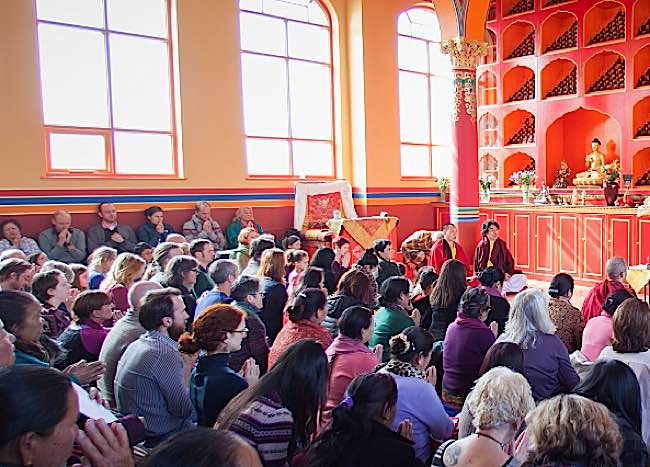 In a formal retreat or group practice be respective of others by not chanting too loudly.
In a formal retreat or group practice be respective of others by not chanting too loudly.
4. Volume and tone
General advice from most teachers is that if you are in public or around other people, mantras should be softly chanted so that you can hear, but others cannot. The goal is not to disturb others. For example, at a counting retreat, generally low volume is desirable.
On the other hand, for celebratory mantras that express our devotion, often known as name praise mantras, a joyful tone is appropriate. For example, when starting a group practice celebrating Amitabha or Avaloktiteshvara, we may musically and joyfully chant our mantras.
For serious practice, and supplication mantras, which are mantras that request activities of Enlightened deities, these are normally outloud, but not at a disturbing volume. If you are alone, as loud as you like, but in public, or group practice with respect for others around you. Normally, these are softly spoken rather than whispered.
For highest yoga practices, where we are self generating or undertaking specific practices, it is best to strictly follow the teachers guidance.
 Studies have shown that babies can benefit from mantras played to them even before birth. Expectant mothers play mantras for unborn babies. Caregivers chant mantras for pets. Neither babies nor pets have faith, but many swear by the effectiveness of mantra. Faith certainly empowers mantra further, as does intention, but some research seems to indicate benefit specifically from the sound and frequency. Full feature>>
Studies have shown that babies can benefit from mantras played to them even before birth. Expectant mothers play mantras for unborn babies. Caregivers chant mantras for pets. Neither babies nor pets have faith, but many swear by the effectiveness of mantra. Faith certainly empowers mantra further, as does intention, but some research seems to indicate benefit specifically from the sound and frequency. Full feature>>
5. Blissfully Musical versus Syllabic
Mantras chanted to a melody or musically tend to be name or praise devotional mantras, or mantras that when repeated for thousands of repetitions become sleep-inducing. Ultimately, to chant musically, or tonelessly is your own preference, unless your specific lineage advises otherwise.
One of the practice areas in Vajrayana is meditating on bliss and emptiness. Bliss and joy are important to Vajrayana meditation. Here, we’re not referring to joy that gives rise to attachment, one of the great poisons in Buddhism. This is bliss that arises naturally from wisdom and compassion. Wisdom is the understanding of Shunyata and Emptiness. When we chant mantras, we are often meditating on emptiness or self generation followed by disssolution. We do this with blissful awareness.
Musicality of mantras can help with blissful awareness. In this case it’s not devotional joy (although it can be) but rather a mindful practice.
For example, if we are chanting healing mantras, it can help to do so melodically. For this reason, Medicine Buddha mantras, and mantras such as Om Mani Padme Hum are often musically chanted. The sense of joy and celebration reinforces the meditation.
Other times, we actually change tones deliberately. Such as, for example, Manjushri’s arapachana mantras, where when we finish our meditation and recitation we allow our voice to dwindle as we intone, over and over again, the seed syllable Dhi. These are techniques that reinforce our mindful practice of mantra.
Some people advocate specific harmonics for some yogic mantras, but these are specific practices and yogas, not general recommendations.
Musicality of mantras is a celebratory practice, and highly meritorious, benefiting all sentient beings.
With music, pronunciation is still correct, but the music adds a rhythm and joy that makes longer-term practice easier and more blissfully energetic.
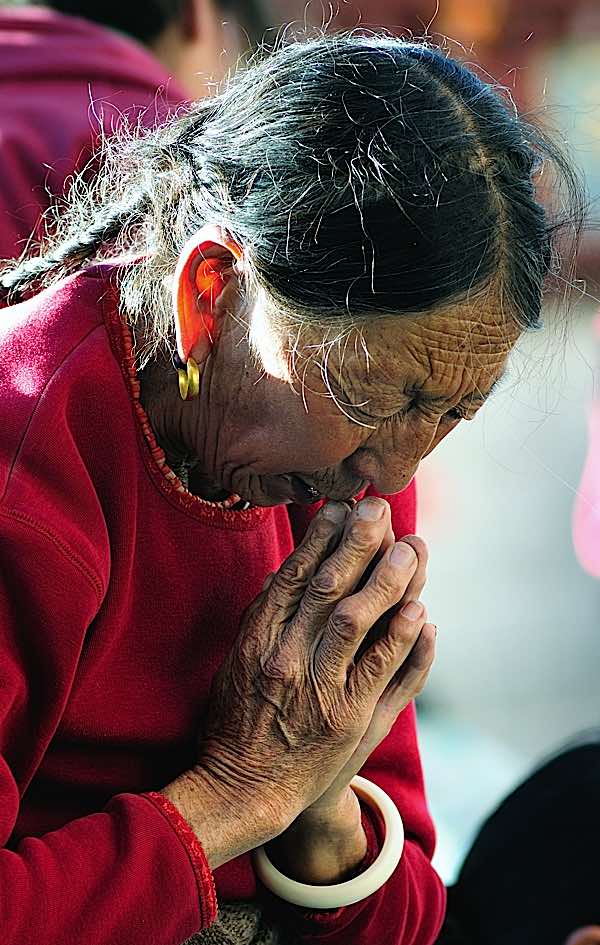 Taking refuge in the Three Jewels Buddha, Dharma and Sangha is a Foundation Practice of all traditions. Before we chant mantras we always take refuge, even if only in an abbreviated form.
Taking refuge in the Three Jewels Buddha, Dharma and Sangha is a Foundation Practice of all traditions. Before we chant mantras we always take refuge, even if only in an abbreviated form.
6. Making Mantra a Complete Practice
Often, whe we are busy, we ask our teachers, “what if I don’t have time for my practice commitments and sadhanas?” Many teachers simply reply, “You have time for a mantra, don’t you?”
This means we can make mantras the focus of our practice. To make it a complete practice, it is vital to always begin by taking refuge in the Three Jewels. This can be as simple as saying “I take refuge in the Three Jewels, the Buddha, the Dharma and Sangha, until I reach Enlightenment for the benefit of all sentient beings.” This includes both Refuge and the all-important Bodhichitta intention.
Chanting the mantras is our complete practice, especially if you combine it with visualization of the deity, and recite clearly and with mindfulness. The mantra itself is both a praise and and offering, as well as a supplication.
Especially important in this case, is to always dedicate the merit of your mantra recitation to the benefit of all sentient beings. This makes it a complete practice. You can dedicate by simply saying, respectfully and sincerely, “I dedicate the merit of this mantra recitation to the cause for Enlightenment for the benefit of all sentient beings.
 A monk using a mala for counting mantras as he walks.
A monk using a mala for counting mantras as he walks.
7. Chant 7, 21, 27, 108 or more Times
Repetition a certain number of times symbolizes not only sincerity, but also creates intentionality. Additional repetitions, above the “minimum” helps in case we miss syllables. The traditional number is 108, with the final making up for any mistakes in recitation, but for longer mantras, or when you are in a rush, you can chant 7, 21, or 27 times. We’ve covered this symbolism in other features.
It is helpful to use a mala for counting and as your mantra support. See our in-depth feature on Guru Rinpoche’s guide to using a mala, linked at the information icon.
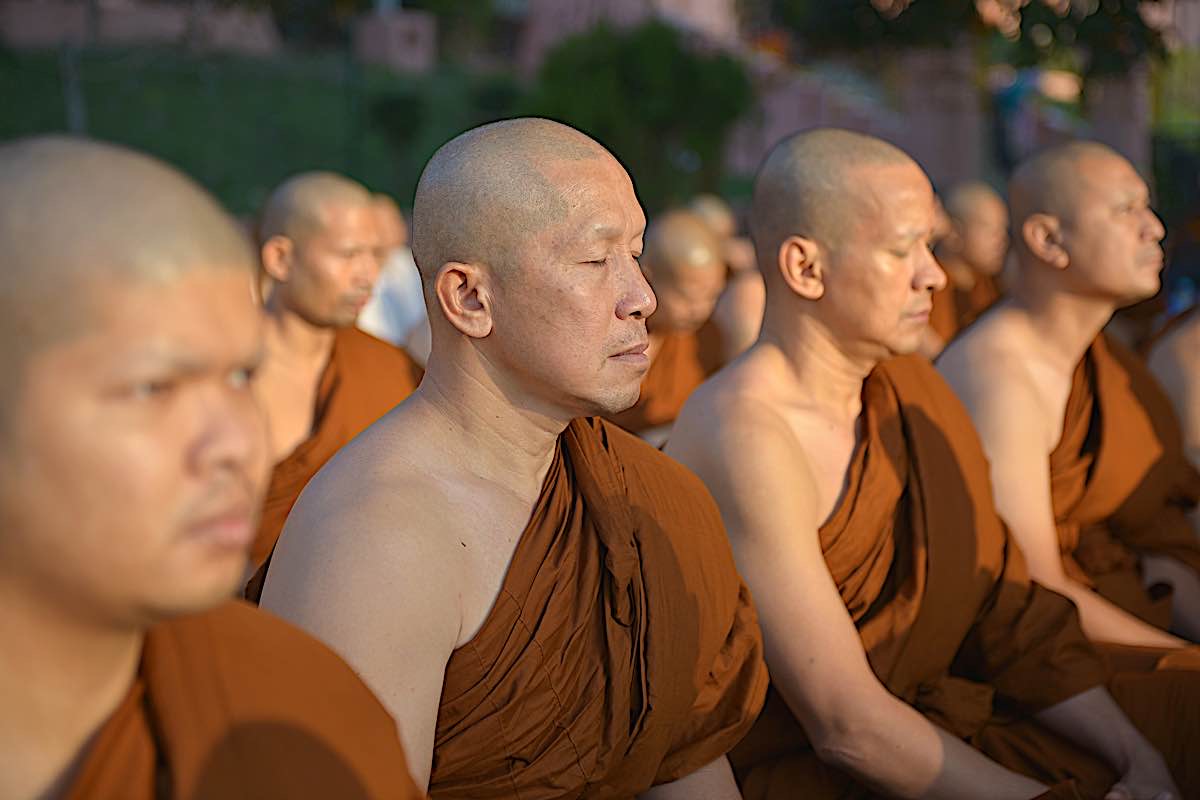 Monks meditating mindfully.
Monks meditating mindfully.
8. Remain Mindful
Although you can chant mantras when walking, doing chores, driving and at other times, as a reinforcing practice, these tasks make it less meditative. Even if you’ve been chanting during rush hour on the way to work — making sure you do not take your concentration off the road — it’s ideal to set aside a few minutes for dedicated mantra practice when you can be fully mindful.
This means, starting with your breathing. Relaxing and settling into a comfortable posture. Then, reciting mindfully, enunciating each vowel carefully. As you do, if you have the concentration, you can engage in visualizations. The simplest is to visualize yourself suffused with light, blessing your body as you recite.
More intense visualizations include imagining the deity in front of you, with light going out from the deity’s heart to all sentient beings in the universe, blessing them, then returning into your own heart, blessing your own body, speech and mind.
 Counters on our mala can keep track of our accumulations. Regardless of counting, chanting a few “extra” mantras makes up for mistakes.
Counters on our mala can keep track of our accumulations. Regardless of counting, chanting a few “extra” mantras makes up for mistakes.
9. Make up for Mistakes
There are three ways you can remedy your mistakes in pronunciation. One, is to recite 10 percent more than you count. The more elaborate method, especially on counting retreats, is to recite every letter of the Sanskrit alphabet. This makes up for any missing sounds. The third is to chant one of the mantras or Dharanis to repair recitation flaws.
A shorter form of “making up for mistakes” is to chant the purifying mantra at the beginning and end of your session. This can be either OM AH HUM which purifies body, speech and mind, or OM SVABHAVA SHUDDO DHARMA SVABHAVA SHUDDHO HAM which is also called the Emptiness or Shunyata mantra. These purify the mantra sounds to essence.
In practice, if we recite several repetitions daily, we’re already symbolically making up for our mistakes by repeating.
Famous mantra for “destroying evil and curses” — this is NOT about destroying a sentient being, but rather than anger and hate within people that inspires evil:
What about all these mantras that “Destroy evil”?
Many mantras, and especially activity mantras, such as those of the 21 Taras or of various protectors, use the word “destroy” in their title. For example, “Destroys evil” or “Destroys enemies.” In the context of Buddhist mantras, it is important to understand that Bodhichitta is not “optional.” Destroying enemies” does not mean your personal enemy will drop dead the next day. Buddhist mantras destroy the enemies of anger, hate, jealousy, rage, anxiety, fear, desire, depression. By destroying the anger, we remove the incentive for people to engage in negative acts such as killing. We destroy the root causes, in Buddhism called the Ten Klesha or Ten Poisons. When all the poisons are removed, we attain, ultimately Enlightenment.
NOTES
[1] https://www.dharmadrum.org/portal_d8_cnt_page.php?folder_id=38&cnt_id=128&up_page=1

 Konoly
Konoly 
































